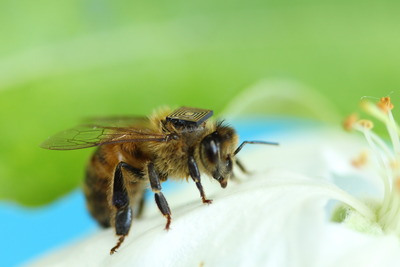E-tags for bees
A world-first research program, led by CSIRO, is monitoring honeybee populations by tracking the insects with tiny sensors - a technique known as ‘swarm sensing’. With 5000 bees taking part in the program, this is the first time such large numbers of insects have been used for environmental monitoring.
CSIRO science leader Dr Paulo de Souza, who leads the project, said honeybees provide “a free pollination service for agriculture, which various crops rely on to increase yields”. He added, “Around one third of the food we eat relies on pollination”, including fruit like apples and cherries.
But Dr de Souza said honeybee populations around the world are crashing. This is due to attacks from Varroa mites - parasites which attack developing bee larvae or adult bees, resulting in deformed bees and reduced life spans - as well as the phenomenon known as colony collapse disorder (CCD), in which worker bees from a beehive or European honeybee colony suddenly disappear.
Dr de Souza said CSIRO’s sensing technology is now being trialled in Hobart in collaboration with the University of Tasmania (UTAS), Tasmanian Beekeepers Association, and local beekeepers and fruit growers. The bees are refrigerated for a short period in order to put them into a rest state, allowing for tiny sensors, measuring 2.5 x 2.5 mm, to be secured to their backs with an adhesive. After a few minutes, the bees awaken and are ready to return to the wild.

The RFID sensors work in a similar way to a vehicle’s e-tag, recording when the insect passes a particular checkpoint. The information is sent remotely to a central location where researchers can use the signals from the sensors to build a 3D model and visualise how the insects move through the landscape.
Dr de Souza said the aim of the technology is to understand the bee’s relationship with its environment. “Bees are social insects that return to the same point and operate on a very predictable schedule,” he said. “Any change in their behaviour indicates a change in their environment.”
This increased understanding, he said, will help maximise productivity and monitor biosecurity risks. It will give farmers and fruit growers improved management knowledge, enabling them to increase the benefit received from the bees’ pollination. It will also help them to gain and maintain access to markets through improving the monitoring of pests.
“Many growers rely on wild bees or the beekeepers to provide them with pollinators so they can improve their crops each year,” he said. “Understanding optimal conditions for these insects will improve this process.”
The next stage of the project is to reduce the size of the sensors to only 1 mm so they can be attached to smaller insects such as mosquitoes and fruit flies. According to Dr Stephen Quarrell of UTAS, “Anything that moves, we can tag it.”
Rethinking IT sustainability
As businesses rethink how they manage their IT infrastructure, embedding sustainability into...
Emissions as data: the challenge of reporting on an invisible metric
The challenge many businesses face is quite apparent: how does one measure emissions? AVEVA says...
The 3 key risks directors need to manage amid climate reporting uncertainty
2025 will be a marker year for climate reporting, and boards should devote attention to three key...










